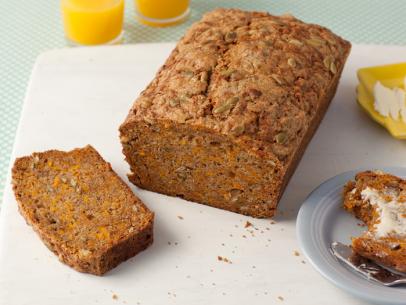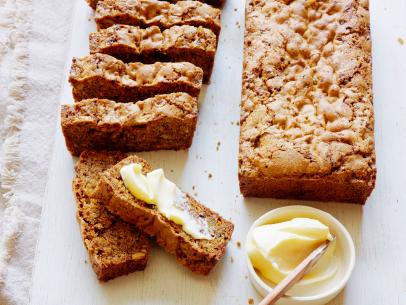
Autumn Pumpkin Bread with Pecans
Getting reviews...
- Level: Easy
- Yield: 2 1 1/4-pound loaves
-
- Nutritional Analysis
- Per Serving
- Serving Size
- 1 of 2 servings
- Calories
- 2246
- Total Fat
- 97 g
- Saturated Fat
- 36 g
- Carbohydrates
- 311 g
- Dietary Fiber
- 20 g
- Sugar
- 80 g
- Protein
- 44 g
- Cholesterol
- 312 mg
- Sodium
- 1783 mg
- Level: Easy
- Yield: 2 1 1/4-pound loaves
-
- Nutritional Analysis
- Per Serving
- Serving Size
- 1 of 2 servings
- Calories
- 2246
- Total Fat
- 97 g
- Saturated Fat
- 36 g
- Carbohydrates
- 311 g
- Dietary Fiber
- 20 g
- Sugar
- 80 g
- Protein
- 44 g
- Cholesterol
- 312 mg
- Sodium
- 1783 mg
Ingredients
Directions
- Place the yeast and warm water in a large bowl and stir with a fork to dissolve the yeast. Allow to stand for about 3 minutes.
- Add the honey, pumpkin puree, milk, egg yolks, cornmeal, and 1 2/3 cups (8 ounces) of the high-gluten flour to the yeast mixture. Stir briskly with a whisk until the ingredients are well combined. Let this sponge stand for at least 15 minutes but not longer than 30 minutes.
- In a medium bowl, whisk the remaining 2 1/3 cups (11 3/4 ounces) high-gluten flour, cinnamon, ginger, cloves, and salt together to mix well. Add to the sponge and stir with your fingers to incorporate the flour, scraping the sides of the bowl and folding the dough over itself until it gathers into a shaggy mass. Knead the dough in the bowl until it becomes smooth and somewhat elastic, about 5 minutes. Gradually add the melted butter, kneading it in gently until well incorporated.
- Move the dough to a lightly floured work surface and knead until it is very smooth, silky, and elastic, about 5 minutes. The dough will be sticky, so keep the work surface and your hands lightly floured, but don't overdo it. The dough should be soft, supple, and springy. Shape the dough into a loose ball, cover it with plastic wrap, and let it rest for 20 minutes. (This rest period is the autolyse.)
- Flatten the dough and stretch it gently with your fingers to form a rectangle about an inch thick. Spread the toasted pecans evenly over the rectangle. Fold the whole mass into an envelope and knead it gently until the nuts are well distributed, about 2 to 3 minutes. If the dough resists, let it rest for 5 minutes and then continue kneading it. Some of the pecans may pop out of the dough, but they can easily be incorporated again after the first rise, when the dough has softened.
- Shape the dough into a loose ball and place it in a lightly oiled bowl, along with any loose pecans. Turn to coat the dough with oil, then cover the bowl tightly with oiled plastic wrap. Let the dough rise at room temperature (75 degrees to 77 degrees F) until it has doubled in volume, about 2 hours.
- While the bread is rising, make a cornstarch wash: Put the cold water in a small saucepan and whisk in the cornstarch. Bring to a boil, stirring frequently until it thickens. Remove from the heat and cover to keep a skin from forming. Set aside to cool.
- When the dough has doubled, gently pour it out of the bowl onto the floured work surface, pressing in any loose nuts. Flour your hands lightly and gently divide the dough into 2 equal pieces (each weighing about 24 ounces). Shape each piece into a knot.
- Generously dust a peel or the bottom of a baking sheet with flour or coarse cornmeal. Carefully place the shaped loaves on the peel or sheet, leaving several inches between them so they won't grow into each other as they rise. Cover the dough with oiled plastic wrap and allow it to rise at room temperature until it has just doubled in volume, about 1 1/2 to 2 hours.
- Thirty minutes before baking, preheat the oven to 425 degrees F. Place a baking stone in the oven to preheat and place an empty water pan directly below the stone.
- When the loaves have doubled, use a pastry brush to paint each loaf with the cornstarch wash. Brush gently so you won't deflate the loaves. (Reserve the remaining cornstarch wash.) Shake the peel or pan gently to be sure the loaves aren't sticking and slide the dough onto the baking stone. Quickly pour 1 cup of very hot water into the water pan and immediately shut the door. After 1 minute, using a plant sprayer, mist the top and sides of the oven 6 to 8 times, then immediately shut the oven door. Repeat the misting procedure 1 minute later.
- Bake for 15 minutes, then reduce the oven temperature 350 degrees F and bake for 20 to 25 minutes longer, until the loaves are golden brown and the surface feels firm but not hard when you press it lightly. These should have a thin soft crust, not a hard crunchy one. Transfer the loaves to a rack and paint them again with the cornstarch wash. Allow to cool completely before serving. This bread is best eaten the day it is baked, but it also freezes exceptionally well if you wrap it in aluminum foil and then a heavy duty plastic freezer bag. Thaw at room temperature before serving.
Looking for Something Else?
Related Pages
- The Best Pumpkin Bread Recipe
- Banana Bread with Pecans Recipe
- Pumpkin Bread Recipe
- Double Chocolate Zucchini Bread with Pecans Recipe
- Mashed Sweet Potatoes with Pecans Recipe
- Shaved Brussels Sprouts Salad with Pecans Recipe
- Double Chocolate Chip Cookies with Pecans Recipe
- Stuffed White Mushrooms with Pecans Recipe
- Cranberry-Grape Sauce with Pecans Recipe































